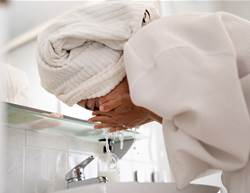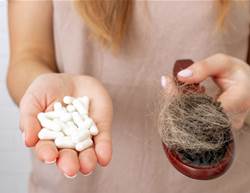Are you feeling like a reptile? We hear you: Dry skin is not only uncomfortable, it can make you feel all scaly, icky, and like a member of the animal kingdom. Unfortunately, it's ubiquitous during periods of cold weather and low humidity, making dry skin almost as much of a winter staple as scarves, mittens, and hot chocolate. But never fear—just because it's common during the winter doesn't mean you have to be stuck with it forever. We asked top dermatologists for the best plan of attack to rid you of those pesky flakes and scales and get back that smooth-as-a-baby's-butt skin. Here are their expert tips to help fight dry skin on (basically) every part of your body, from your head to your toes:
Your face
What to do: Once flaking begins, going gentle is the golden rule for your face. Opt for mild, soap-free facial cleansers and lukewarm water to cleanse, and then pat skin dry and immediately apply moisturiser. If you feel you need more hydration, use a hyaluronic-acid serum underneath your moisturiser to pull in even moisture, advises dermatologist Dr Sejal Shah. hyaluronic acid can absorb up to 1000 times its weight in water, making it super-effective at trapping in moisture.
How to prevent it: Avoid harsh soaps and ingredients that leave your face feeling dry immediately after application. If you're using retinol, or drying treatment products (like acne medicated lotions), cut back how frequently you use them to every other day or less, or lower the concentrations. And go easy on the exfoliators, whether they're scrubs or chemical peels. "It's important to gently exfoliate regularly, but make sure you're not over-exfoliating, which will dry skin out," says Shah. Also, using a humidifier in your home to add moisture to the air can help your skin hydrate itself, adds Shah.
Your legs and arms
What to do: Sorry—you've got to say goodbye to those long, hot showers. (Find out the ideal shower temp here.) It actually strips moisture if your legs and arms are flaking, says dermatologist Dr Jeremy Green. Limit showers to less than 10 minutes at warm (not hot) temps, and then apply a rich moisturiser immediately after stepping out of the shower. Look for ceramides, which replenish skin's natural barrier, says Green. If you're especially flaky, or rough and bumpy, a formula that adds salicylic acid for gentle exfoliation will help smooth skin.
How to prevent it: Similar to treating flaking faces, both Shah and Green recommend a humidifier for your bedroom if your legs and arms are feeling the dehydration and itch, too. Heaters rob the air of moisture, and a humidifier helps put that moisture back into the air, explains Green. Remember to change the water every day to keep your humidifier air healthy and bacteria-free.
Your scalp
What to do: Skin flaking off the scalp is most likely seborrheic dermatitis, the medical term for dandruff, explains Green. Many people think washing their hair will make flaking worse, but actually washing regularly—at least every other day—with a medicated shampoo, is what will improve the condition, says Green. Look for shampoos with ingredients like selenium sulfide or zinc pyrithione to effectively treat your scalp. If your dandruff is still stubborn, see your dermatologist for a prescription-strength remedy like ketoconazole 2% shampoo, or an anti-inflammatory medication like clobetasol foam, adds Green.
How to prevent it: Regular care, once the dandruff is treated, should include gentle moisturising shampoos and conditioners, regular weekly deep conditioning or hot oil treatments, or other hydrating treatments like hair masks, says Shah. Also, make sure you aren't over-washing or under-washing your hair—our dermatologists say about every other day is just right—as either extreme can cause flaking.
Your feet
What to do: Moisturise daily by applying a thick cream or ointment at night, and then topping with white cotton socks to help lock in the moisture, says Shah. Rich ingredients like cocoa butter, shea butter, and vitamin E are soothing for the feet. Formulas that contain keratolytics, like urea or lactic acid, can be especially helpful if you suffer from thickened calluses on the feet, she adds.
How to prevent it: Regular exfoliation on thickened areas with a pumice stone is key to keeping soft feet, says Shah. Sometimes stubborn flaky skin on the feet that isn't relieved by over-the-counter methods can mean a medical condition like the fungal infection known as athlete's foot. So if flakes persist even after you try these tips, see a doctor, says Shah.
The article originally appeared on Women’s Health US.



.jpg&h=90&w=90&c=1&s=1)






